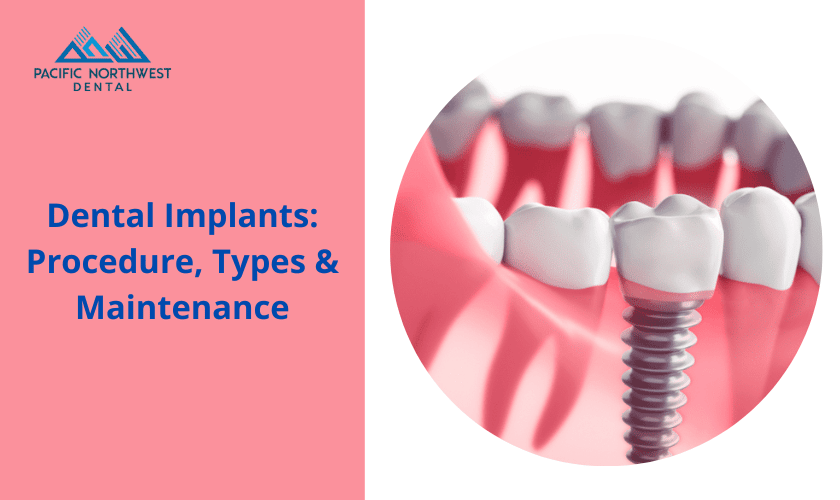
Dental implants can help to restore your missing teeth and help you enjoy your favorite food items again. Our dentists at Pacific Northwest Dental have provided all the information on dental implants in this blog.
What Are Dental Implants?
Dental implants are metal posts or frames placed surgically behind your gums in the jawbone. Once in position, they make it possible for your Beaverton dentist to attach replacement teeth to them.
How Do Dental Implants Work?
Implants support false teeth securely because they fuse to your jawbone. The dentures and bridges, as well as individual crowns affixed over implants, feel more natural than traditional bridges or dentures, thanks to this snug fit. Dentures and bridges won’t slip or shift in your mouth when attached to implants, which is a crucial advantage when speaking and eating.
An advantage of implants is that your new replacement tooth or teeth don’t need to be ground down or prepped to be secured in place. Due to painful areas, inadequate ridges, or gagging, some patients find that traditional bridges and dentures are neither comfortable nor practical. Additionally, the teeth on each side of the gap caused by the lost tooth must be fitted with standard bridges. You need a solid bone to support the implant and healthy gums to obtain implants. You must also promise to maintain the health of these structures. The long-term success of dental implants depends on meticulous oral care and frequent dental checkups at our dental office. Most insurance companies usually only pay less than 10% of the costs for implants, frequently more expensive than other tooth replacement options.
How Many Types Of Implants Are There?
There are two types of implants that the American Dental Association deems to be secure. They are as follows:
Endosteal Implants
These are inserted directly into the jawbone by surgery. After the gum tissue around the implant has recovered, a second procedure is required to attach a post to the initial implant. The final step involves attaching a prosthetic tooth (or teeth) to the post, either singly or in a group, as part of a bridge or denture.
Subperiosteal Implants
They are made of a metal frame attached to the jawbone beneath the gum line. The frame is fixed to the jawbone while the gums recover. Through the gums are posts that are connected to the edge. The posts are subsequently attached with fake teeth, like with endosteal implants.
Maintenance Of Dental Implants
A person must continue to frequently brush and floss their teeth after having dental implant surgery. The same upkeep and care must be given to artificial teeth as natural teeth. You should visit your Beaverton dentist every six months for a thorough cleaning. Additionally, your dentist in Beaverton will arrange follow-up appointments to check on the implants and ensure that the teeth and gums are in good condition.
We hope this blog has helped you to learn more about dental implants. Get in touch with us at Pacific Northwest Dental for the best dental implants in Beaverton, OR.
